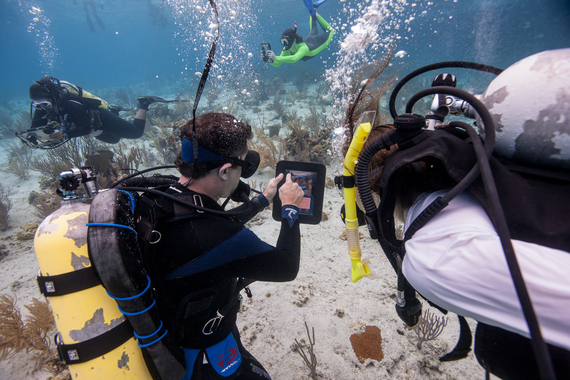On the last EcoWatch report card our oceans received a "D" grade. This grade is based on factors including pollution, overfishing and the impacts of climate change, biodiversity, carbon storage, coastal protection, clean waters, natural products, coastal livelihoods, economies, tourism and recreation. What is most frightening is that we don't know how far we can go before hitting a point of no return to improve and restore our ocean's health.
What is inspiring is that we may be about to experience a revolution in what work, play and education underwater looks like. Recent technological breakthroughs and innovative products may be able to speed up documenting and helping ocean health by allowing us to take everyday devices such as our tablets well below the surface. For example, the iDive, a pressurized housing for iPads, allows users to interact with the touchscreen up to 100+ meters below the surface of the water. Now you can use a mobile device underwater rather than just keep it from dying if it is dropped in the water.
71% of our planet is made up of water, so what can happen with the ability to use a mobile device underwater? What will happen now that there is 'an app for that' for the first time in the underwater world? What innovative applications will be dreamed up to enhance our underwater lives and help our planet?
Initially microbiologists, scientists and engineers can download PDFs of blueprints and manuals to build and weld bridges and pipelines, communicate, and use documents and note taking apps to catalog species and note the health of coral reefs. Scuba instructors, photographers, videographers, recreational divers and snorkelers can enhance their dives with check lists, fish guides, dive site maps and music. NASA and the U.S. Navy can enhance their communication and tasks for zero gravity training. Commercial divers can go deep, stay long and when they have to come up slowly and stop at specific depths to decompress they can read books, watch movies or play games. Long decompression stops are like commuting to work so why shouldn't divers be able to do what we do on our commutes in cars, trains, buses and planes?
Data collection of species tracking is currently spread across several global databases like the World Register of Marine Species and the MarineBio Species Database that require manual entry steps. But imagine what else will be possible as the general public begins to come up with ideas for underwater apps, when bluetooth technology eventually works underwater, and people like citizen scientists note the health of their local water systems and share information through collective data sharing.
Organizations like REEF, Reef Check, Shark Savers and the Cousteau Society have standardized collection methods and recording on waterproof paper or on slates and fill out forms on each dive and then mail the data to someone who inputs the data. Now they can more accurately note data into an iPad while working underwater and then easily upload the data when they return to the shore. Crowd sourcing to save reefs and water species can move out of doing things the 20th century way.
Animal tracking by citizen scientists can record what they see into websites to help with conservation, track patterns of die-offs, understanding how many animals are in a part of the world at one time, population sizes, predatory species spreading, migratory patterns.
Similar to the Christmas Bird Count, people who love our oceans and lakes can participate in activities that connect them in a way they might not otherwise be connected while sharing more accurate data, and connecting the data into connected networks to share findings that support nature conservation. Maybe one day we'll even have a Christmas fish count to rival the Christmas bird count where the average person can make significant contributions to scientific data that makes a real difference.
Now that consumer technology is dipping into the water we can learn and share more about sea life. As we engage more deeply with our underwater worlds our chances become greater to save more species and strengthen ocean life around the globe.

